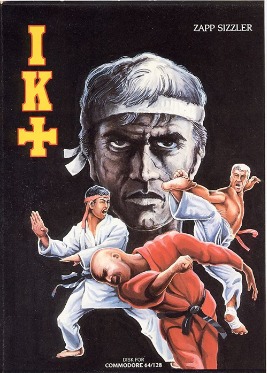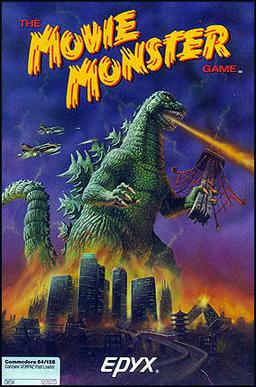
Alter Ego is a role-playing video game developed and published by Activision in 1986. It was created by Peter J. Favaro for the Commodore 64, DOS, Apple II, and the Apple Macintosh. The game allows the user to make decisions for an imaginary person and shows what possible consequences these decisions could have on that person. Alter Ego was released in both male and female versions, each using a different set of experiences.

The Bard's Tale II: The Destiny Knight is a fantasy role-playing video game created by Interplay Productions in 1986. It is the first sequel to The Bard's Tale, and the last game of the series that was designed and programmed by Michael Cranford.

International Karate +, stylized as IK+, is a fighting game written by Archer Maclean and published in 1987 by System 3 for the Commodore 64, Amstrad CPC, and ZX Spectrum. It is a successor to International Karate (1985). Activision published the Commodore 64 version in the US as Chop N' Drop.

Spellbreaker is an interactive fiction video game written by Dave Lebling and published by Infocom in 1985, the third and final game in the "Enchanter Trilogy." It was released for the Amiga, Amstrad CPC, Apple II, Atari 8-bit computers, Atari ST, Commodore 64, Classic Mac OS, and MS-DOS. Infocom's nineteenth game, Spellbreaker is rated "Expert" difficulty.

Skyfox is a combat flight simulation game developed by Ray Tobey for the Apple II and published by Electronic Arts in 1984. Ariolasoft published the game in Europe. It was released for the ZX Spectrum, Amstrad CPC, Commodore 64, and Macintosh in 1985, to the Amiga and Atari ST in 1986, and to the PC-88 in 1988.

The Three Stooges is a video game released by Cinemaware in 1987 for the Amiga based on the comedy trio of the same name. Players control Stooges Moe, Larry, and Curly in minigames based on Stooges films with the aim of raising enough money to save an orphanage. It was ported to the Apple IIGS, Commodore 64, MS-DOS, NES and Game Boy Advance. The game has been praised as a faithful adaptation of the Stooges films, but has been criticized for repetitive gameplay and limited replay value.

The Faery Tale Adventure is a 1987 action role-playing video game designed by David Joiner and published by MicroIllusions for the Amiga, and later ported to the Commodore 64, MS-DOS, and Sega Genesis. The MS-DOS version is titled The Faery Tale Adventure: Book I. Microillusions also released a "Book 1" version for the Amiga which was going to be the start of a series of games, according to Talin, but bankruptcy prevented it. The initial version was produced for the Amiga 1000 and featured the largest game world to that date. A sequel, Faery Tale Adventure II: Halls of the Dead, was released in 1997.

Labyrinth: The Computer Game is a 1986 graphic adventure game developed by Lucasfilm Games and published by Activision. Based on the fantasy film Labyrinth, it tasks the player with navigating a maze while solving puzzles and evading dangers. The player's goal is to find and defeat the main antagonist, Jareth, within 13 real-time hours. Unlike other adventure games of the period, Labyrinth does not feature a command-line interface. Instead, the player uses two scrolling "word wheel" menus on the screen to construct basic sentences.

J.R.R. Tolkien's The Lord of the Rings, Vol. I is a role-playing video game published by Interplay Productions. It is an adaptation of The Fellowship of the Ring by J. R. R. Tolkien, being the first volume in The Lord of the Rings. The game was released in 1990 for DOS, in 1991 for the Amiga and PC-98, and in 1992 for the FM Towns. It was followed by J.R.R. Tolkien's The Lord of the Rings, Vol. II: The Two Towers. It was originally designed for the Commodore 64, but the production team switched to the newer platforms. The game was designed by Troy A. Miles, Scott Bennie, Jennell Jaquays, and Bruce Schlickbernd. For the later versions, the cutscenes are taken from the 1978 Lord of the Rings film directed by Ralph Bakshi.

Tass Times in Tonetown is an adventure game published by Activision in 1986. It was designed by Michael Berlyn and Muffy McClung Berlyn and programmed by Rebecca Heineman of Interplay in cooperation with Brainwave Creations.

Spindizzy is an isometric video game released for several 8-bit home computers in 1986 by Electric Dreams Software. It combines action and puzzle video game elements. Players must navigate a series of screens to explore a landscape suspended in a three-dimensional space. Development was headed by Paul Shirley, who drew inspiration from Ultimate Play the Game games that feature an isometric projection.

The Movie Monster Game is a computer game released by Epyx for the Apple II and Commodore 64 in 1986. The game offers a variety of scenarios, playable monsters, and cities to demolish. The monsters are based on popular movie monsters such as The Blob, Mothra, the Stay Puft Marshmallow Man, and the Transformers, and Epyx was able to officially license Godzilla.

Arcticfox is a science fiction tank simulation video game developed by Dynamix and published by Electronic Arts in 1986. It was published in Europe by Ariolasoft. A sequel to Dynamix's Stellar 7, Arcticfox was developed for the Amiga as one of the platform's first titles but was quickly ported to other platforms including the Atari ST, Commodore 64, ZX Spectrum, MS-DOS and Apple II. A third game was released in the series in 1991 titled Nova 9: The Return of Gir Draxon.

Hacker II: The Doomsday Papers is computer game written by Steve Cartwright and published by Activision in 1986. It is the sequel to the 1985 game Hacker. Hacker II was released for the Amiga, Apple II, Apple IIGS, Amstrad CPC, Atari ST, Commodore 64, IBM PC, Macintosh, and ZX Spectrum.

Moebius: The Orb of Celestial Harmony is a video game produced by Origin Systems and designed by Greg Malone. It was originally released in 1985 for the Apple II. Versions were also released for the Amiga, Atari ST, Commodore 64, Macintosh, and MS-DOS. The game is primarily a top-down view tile-based role-playing video game, but it has action-based combat sequences which use a side view, roughly similar to games such as Karateka.

Shanghai is a computerized version of mahjong solitaire published by Activision in 1986 for the Amiga, Atari ST, Atari 8-bit computers, Commodore 64, MS-DOS, classic Mac OS, Apple IIGS, and Master System. Shanghai was originally programmed by Brodie Lockard. It was released as an arcade video game by Sunsoft in 1988.

The Chessmaster 2000 is a computer chess game by The Software Toolworks. It was the first in the Chessmaster series and published in 1986. It was released for Amiga, Apple II, Atari 8-bit computers, Atari ST, ZX Spectrum, Commodore 64, Amstrad CPC, MSX, Macintosh, and IBM PC compatibles.

Temple of Apshai Trilogy is a remake of three games from the Dunjonquest series, Temple of Apshai, Upper Reaches of Apshai, and Curse of Ra.

Ghostbusters II is a 1989 action game based on the film of the same name. It was published by Activision for various computer platforms. British studio Foursfield developed a version for Commodore 64, Amiga, Atari ST, Amstrad CPC and ZX Spectrum, which also got ported to the MSX by New Frontier. It features three levels based on scenes from the film. Dynamix developed a separate version for the DOS, also based on the film. The non-DOS versions were praised for the graphics and audio, but criticized for long loading times, disk swapping, and the final level. The DOS, Commodore 64 and Amiga versions were the only versions released in North America.
Rob Swigart is an American novelist, poet, short story writer, futurist, and archaeology scholar best known for his satirical work, archaeology writing, science fiction, and interactive novel computer game, Portal. He is the author of sixteen books, including fourteen novels, one business book, and one translated prose poem.




















